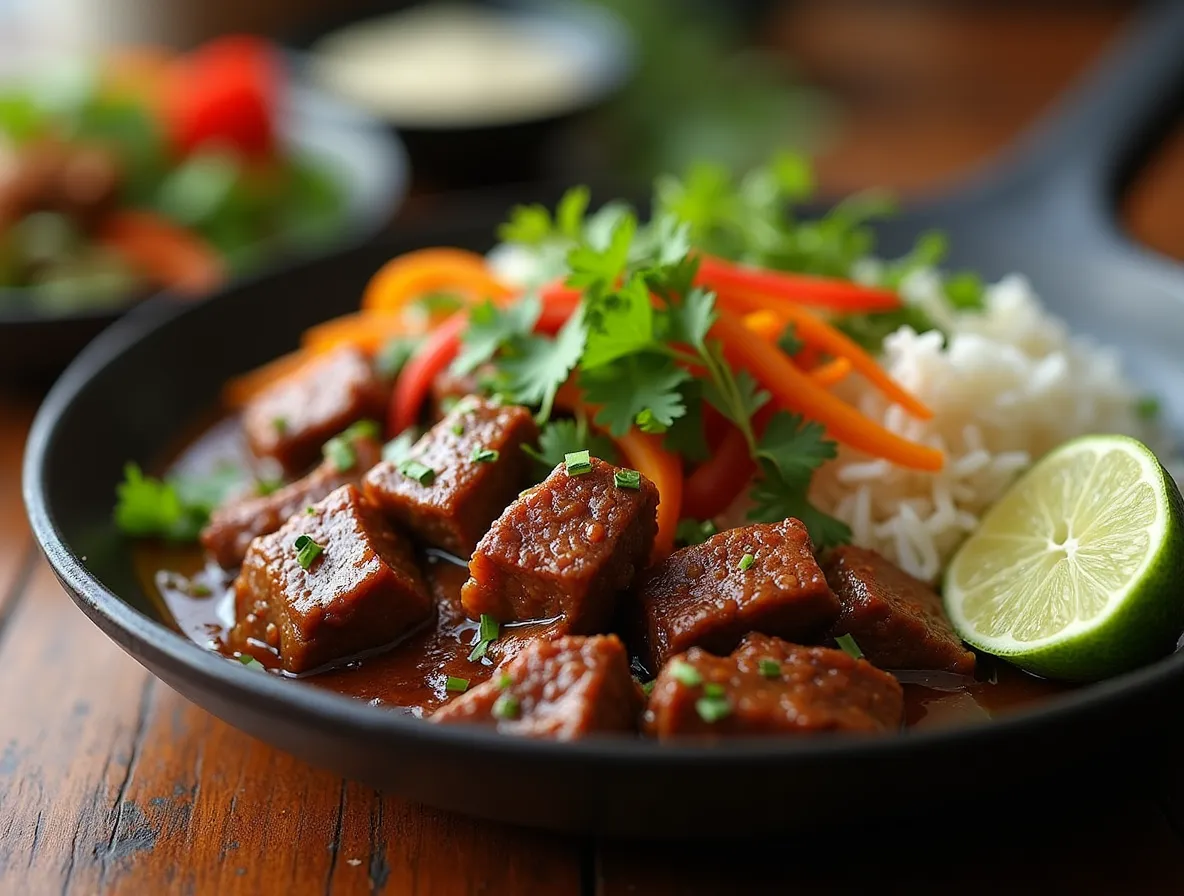
Table of Contents
7 Simple Steps to Make the Perfect Bo Luc Lac Recipe
If you’ve ever dreamt of recreating the mouthwatering flavors of Vietnamese street food in your own kitchen, the Bo Luc Lac recipe is your perfect starting point. Also known as shaking beef, this savory dish features tender beef cubes seared to perfection with aromatic garlic, tangy lime, and a savory sauce. The sizzling sound of the beef shaking in the pan is part of what makes this dish so iconic.
Whether you’re hosting a dinner for friends or preparing a quick yet flavorful weeknight meal, Bo Luc Lac brings the bold flavors of Vietnam right to your table. In this guide, we will walk you through every step of making this delicious dish, from selecting the right ingredients to mastering the cooking technique. Ready to impress your taste buds with a classic Vietnamese dish? Let’s dive into this Bo Luc Lac recipe and learn how to make this mouthwatering meal from the comfort of your kitchen.
Table of Contents
- What is Bo Luc Lac?
- Key Ingredients for Bo Luc Lac
- Essential Ingredients
- Optional Ingredients
- Step-by-Step Bo Luc Lac Recipe
- Marinade Preparation
- Cooking Instructions
- How to Serve and Pair Bo Luc Lac
- Pro Tips for Perfect Bo Luc Lac
- Common Mistakes to Avoid
- FAQs about Bo Luc Lac Recipe
- Conclusion: Your Go-To Shaking Beef Recipe
What is Bo Luc Lac?
If you’re unfamiliar with Bo Luc Lac, it’s time to get acquainted with one of the most beloved dishes in Vietnamese cuisine. This dish is a stir-fry made with tender beef that is quickly seared and “shaken” in the pan to create a delicious caramelized exterior while maintaining a juicy, medium-rare interior. The name itself, Bo Luc Lac, literally translates to “shaking beef,” referring to the signature technique where the beef cubes are tossed or shaken in the pan during cooking.
Originally served as a street food or at family gatherings in Vietnam, shaking beef has now become a global sensation. The recipe’s simplicity, combined with its bold flavors, has made it a popular choice among home cooks and chefs alike.
But what makes Bo Luc Lac so special? It’s the marriage of sweet, savory, and tangy flavors, the slight crunch of fresh herbs, and the sizzling sound of the beef cooking in the hot pan. It’s not just a meal – it’s an experience.
Key Ingredients for Bo Luc Lac
Before you start cooking, it’s essential to gather the right ingredients. Here’s a breakdown of what you’ll need to make Bo Luc Lac come to life.
Essential Ingredients
- Beef: The star of the dish! You’ll want to choose a tender cut of beef that cooks quickly, such as sirloin, ribeye, or tenderloin. These cuts are ideal because they’re juicy and tender when cooked properly.
- Garlic: A couple of cloves of garlic are essential to infuse the dish with that aromatic depth. Mince the garlic finely to get the most flavor out of it.
- Soy Sauce: This ingredient provides the savory umami base for the marinade and helps balance the sweetness and acidity of the other ingredients.
- Oyster Sauce: Adds complexity and depth to the flavor profile, giving the beef a slightly sweet and salty taste.
- Sugar: Just a teaspoon of sugar will help balance the salty and tangy flavors. It also assists in caramelizing the beef during cooking.
- Lime or Lemon: Fresh lime or lemon juice adds a citrusy zing to the dish, cutting through the richness of the beef and giving it a refreshing kick.
- Black Pepper: Ground black pepper provides a mild heat and an earthy kick to the dish. It enhances the beef’s natural flavors.
- Cilantro: Fresh cilantro leaves bring a burst of color and a fresh, herbaceous flavor. It’s used as a garnish to top off the dish.
Optional Ingredients
- Bell Peppers: Adding bell peppers, either red or yellow, provides a crunchy texture and a touch of sweetness that complements the beef perfectly.
- Onions: Thinly sliced onions add a mild sweetness when sautéed. You can use white, yellow, or red onions, depending on your preference.
- Vinegar: Some variations of Bo Luc Lac include a touch of vinegar in the marinade to enhance the dish’s acidity. This is optional but can add an extra layer of flavor.
Step-by-Step Bo Luc Lac Recipe

Now that you have all your ingredients ready, let’s break down the recipe step by step. Follow these instructions carefully, and you’ll be enjoying shaking beef in no time!
Marinade Preparation
- Combine the Marinade Ingredients: In a medium bowl, mix together:
- 2 tablespoons soy sauce
- 1 tablespoon oyster sauce
- 1 teaspoon sugar
- 1 minced garlic clove
- 1 teaspoon black pepper
- Juice of half a lime (or lemon)
- Prepare the Beef: Slice your beef into bite-sized cubes, ensuring that each piece is about 1-inch in size. This ensures that the beef cooks evenly and quickly.
- Marinate the Beef: Add the beef cubes to the marinade and toss to coat them evenly. Let the beef sit in the marinade for at least 30 minutes. This allows the flavors to penetrate the meat, making it more flavorful.

Cooking Instructions
- Heat the Pan: Place a wok or large skillet on the stove over medium-high heat. Let it get very hot before adding any oil – this is key for achieving a perfect sear on the beef.
- Cook the Beef: Once the pan is hot, add a little oil (vegetable or canola oil works well). Add the marinated beef in a single layer, ensuring that the pieces don’t overcrowd the pan. Let the beef sear without moving it for 1-2 minutes. After that, gently shake the pan to toss the beef. This “shaking” motion is what gives the dish its name.
- Add the Garlic and Optional Vegetables: After the beef has seared, toss in the minced garlic and optional bell peppers and onions. Stir-fry everything together for another 1-2 minutes until the garlic is fragrant and the vegetables are slightly tender.
- Check for Doneness: The beef should be slightly browned on the outside while remaining tender and pink on the inside. If you like your beef more well-done, cook it a bit longer, but be careful not to overcook it.
How to Serve and Pair Bo Luc Lac
After all that hard work, it’s time to enjoy your Bo Luc Lac. Here are some ways to serve and pair it:
- With Steamed Rice: The classic way to serve Bo Luc Lac is with a bowl of steaming white rice. The rice soaks up all the flavorful juices from the beef, creating a balanced, hearty meal.
- On a Bed of Lettuce: For a lighter, fresher twist, serve the beef on a bed of crisp lettuce leaves. The crunch of the lettuce adds a refreshing contrast to the rich beef.
- Pair with Drinks: A cold Vietnamese beer pairs beautifully with Bo Luc Lac, balancing out the richness of the dish. Alternatively, an iced tea with lime is a refreshing, non-alcoholic option.
Pro Tips for Perfect Bo Luc Lac
- Use a Hot Pan: A very hot pan is essential to getting that signature sear on the beef. This caramelizes the exterior and locks in the juices, keeping the beef tender inside.
- Don’t Overcrowd the Pan: If you add too many pieces of beef to the pan at once, they will steam rather than sear. Cook the beef in batches if necessary.
- Let the Beef Rest: After cooking, let the beef rest for a few minutes before serving. This allows the juices to redistribute, making the beef even more tender.
Common Mistakes to Avoid
- Overcooking the Beef: One of the most common mistakes is overcooking the beef. Since the pieces are small and cook quickly, it’s easy to let them cook too long, resulting in tough meat. Aim for a medium-rare or medium finish.
- Using Tough Cuts: Tough cuts of beef, like chuck or round, are not ideal for Bo Luc Lac. They don’t cook quickly and can become chewy when stir-fried. Stick to tender cuts like sirloin, ribeye, or tenderloin for the best results.
- Skipping the Marinade: The marinade is essential to infuse the beef with flavor. If you’re short on time, marinate the beef for at least 30 minutes, but overnight marination will yield even better results.

FAQs about Bo Luc Lac Recipe
What cut of beef is best for Bo Luc Lac?
For the best results, use tender cuts like ribeye, sirloin, or tenderloin. These cuts cook quickly and stay juicy.
Can I make Bo Luc Lac with chicken or pork?
While Bo Luc Lac is traditionally made with beef, you can certainly substitute with chicken or pork. Just make sure the meat is cut into small, bite-sized pieces for quick cooking.
How do I store leftover Bo Luc Lac?
Store leftover Bo Luc Lac in an airtight container in the fridge for up to 2 days. Reheat gently to preserve the tenderness of the beef.
Can I add vegetables to Bo Luc Lac?
Yes! You can add bell peppers, onions, mushrooms, or other veggies to enhance the dish’s flavor and texture.
Conclusion: Your Go-To Shaking Beef Recipe
Congratulations! You’ve now mastered the art of making Bo Luc Lac, the famous Vietnamese shaking beef that’s bound to impress anyone at your table. With this recipe, you can recreate an authentic, flavorful dish in the comfort of your own kitchen. The tender beef, aromatic garlic, fresh herbs, and tangy lime will transport you straight to the vibrant streets of Vietnam.
Now that you have the knowledge and the skills, it’s time to cook up this incredible dish. Don’t forget to experiment with your own variations, and enjoy every bite!
Get cooking and let the flavors of Vietnam take over your kitchen!
This article is designed to not only guide you through making Bo Luc Lac but also ensure you have all the information needed to create the perfect dish every time. Enjoy cooking, and share your success with your friends and family!
f you’re new to Vietnamese cuisine, Bo Luc Lac (shaking beef) is a great entry point. For more about the origins of Vietnamese food, you can check out this guide to Vietnamese cuisine by Serious Eats. It provides a deep dive into the cultural influences that shape dishes like Bo Luc Lac.
To understand how soy sauce and oyster sauce enhance the flavor of Asian dishes, this article on soy sauce from Britannica explains the history and uses of these ingredients in cooking.
For a detailed explanation of the techniques behind stir-frying and “shaking” dishes like Bo Luc Lac, you can read this comprehensive stir-frying guide on The Kitchn. This will help you understand how to get the perfect sear and texture on your beef.
By linking to high-quality external sources like Serious Eats, Britannica, and The Kitchn, you provide your readers with additional valuable context while boosting the SEO authority of your article. Just ensure these links are relevant and helpful to your content, and they will contribute to a better overall user experience.


**mindvault**
mindvault is a premium cognitive support formula created for adults 45+. It’s thoughtfully designed to help maintain clear thinking